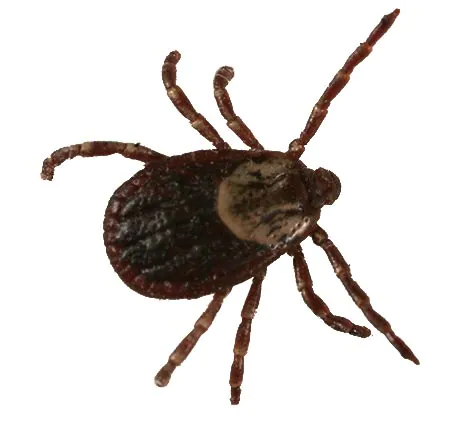By Alan Marble
Every summer you catch a story in the news about a horrific accident on US-2 or M-28 in the western UP in which a vehicle, inexplicably, veers across the center line and plows into the ditch or, worse yet, another vehicle. Forensic examination of the people and vehicles involved reveal nothing as to the potential cause of the awful wreck. The accident is written up as “operator error” and left to the archives.
However, I believe I know the cause of these accidents. While this is pure speculation on my part, I have a pretty good idea as to who the culprit is. It isn’t alcohol, or distracted driving while surfing the internet. The culprit is the wood tick. After pulling a tick from one’s dog or one’s own neck while recreating outdoors in the woods, a person develops an instant sensitivity to any soft touch to the hairline or behind the ear. Once you have encountered an engorged grape-like tick, full of your blood or that of your faithful furry friend, your sensitivity is then off the chart. Nightmarish creatures, the ticks. They live patiently awaiting a warm-blooded victim to come just close enough to clamber aboard. They will ride for hours and even days in the cuff of your trousers or the fold of your sweater, creeping with a molasses-like pace towards contact with warm skin. Insidious is an adjective that comes to mind.
 Wood tick, American dog tick, one and the same. There are actually five species of ticks which occur in Michigan, but the dog tick and the deer tick are the most common, and most likely to be encountered and to pass on infections. They are not insects, but arachnids, more closely akin to spiders. They have eight legs and hard shells, and live in wooded and grassy areas throughout the state. They are becoming more common, it seems, and more widespread, perhaps in response to the changing climate. They are active in May and on into November in our area.
Wood tick, American dog tick, one and the same. There are actually five species of ticks which occur in Michigan, but the dog tick and the deer tick are the most common, and most likely to be encountered and to pass on infections. They are not insects, but arachnids, more closely akin to spiders. They have eight legs and hard shells, and live in wooded and grassy areas throughout the state. They are becoming more common, it seems, and more widespread, perhaps in response to the changing climate. They are active in May and on into November in our area.
Ticks lay around in the grass and woods most of the time, bingeing on Netflix while noshing on bonbons and popcorn, or some equivalent anyway. A tick detects a potential host by sensing odor, moisture, movement and simple vibrations. A comical scene occurs in my head, imagining a slow-moving tick trying to head a Labrador off at the pass. Once a tick selects its host, gets a head start and actually scrambles aboard, it selects a suitable location on said host, and begins to bury its mouthparts into the unsuspecting creature.
If undetected by the host, the tick begins the awful process of engorging itself with its victim’s blood, in preparation of breeding and starting all over again. There is something particularly odious about parasites; those freeloaders which are looking for much more than spare change are actually out for blood. If the tick plays its cards right, it fills up and drops off and starts laying eggs. Yuck.
At any stage in this frightful process a human can intervene. If the tick is attached to a beloved human being (including oneself), there is a strong urge to yank it off without thought or ceremony. If attached to one’s pet, the urgency is a bit tempered. In either case, the secret is to use tweezers or one of the many tools specifically designed for the process to grasp or trap the head of the tick as close to the skin as possible and slowly . . . and I mean slowly . . . pull backwards with steady pressure to back the little SOB out, mouth parts and all.
The next step is crucial. If you have a propane torch, ignite the flame and roast the tick. Lacking a torch, use a sledge hammer to crush its tough carapace (unless the tick is engorged with blood, in which case a serious gory mess results). Seriously, though, you want to ensure that this particular creature does not survive to haunt you, your pets or your house.
Along with the prickly revulsion that accompanies a tick bite, there can be serious health consequences. Ticks removed within 12 hours of attachment are highly unlikely to pass on diseases like Lyme disease or Rocky Mountain spotted fever. In any instance of a tick attachment, the affected area needs to be cleaned, disinfected and watched for any sign of major inflammation or characteristic “bullseye”- like circles surrounding the site. If in doubt, consult a physician.
There is a vaccine available for dogs for Lyme disease, and I am told that a major pharmaceutical company is working on a vaccine for humans. There are many topical drug applications for pets which work well in that the drug repels ticks and, if one stays on long enough to attach, the serum kills the attached tick.
There is a world of good information available on ticks and tick-borne illness on the web. Choose your sites for information carefully to ensure you are reading sound scientific and medical information. Click here to see our own Assembly Ecology Committee web page that has more information and resources.
Common sense prevails. During tick season it pays to be vigilant with your loved ones and your furry friends. A quick inspection of outer clothing at days’ end can pay off. There are effective tick repellents available, but the ones which actually work are for application only to outer garments, and not directly to skin. One trick that may actually work is to apply duct tape, sticky-side out, on trousers below the knee. Ticks seem to like to crawl uphill, and will be snared by the tape. If nothing else, the tick(er) tape can indicate if you are indeed in an area with ticks.
If there is an unsung natural hero through all of this, it is the unlovely opossum. Our only native marsupial, these rat-tailed creatures mosey through life at an ungainly gait during twilight and darkness, eating pretty much everything organic which they encounter. This includes ticks and tick eggs. One University of Illinois study indicated that an adult opossum may consume 5,000 ticks per season. Makes me want to pick up one of those guys and plant a big smooch in thanks on its chin, except they always want to play dead when you approach, and that is a little off-putting to me.
